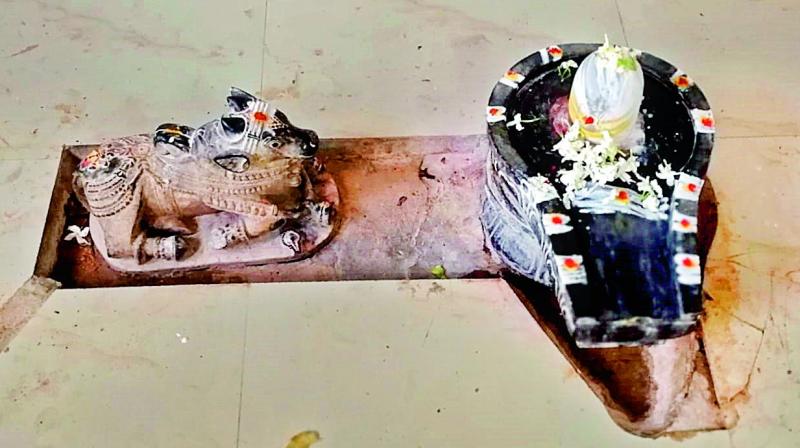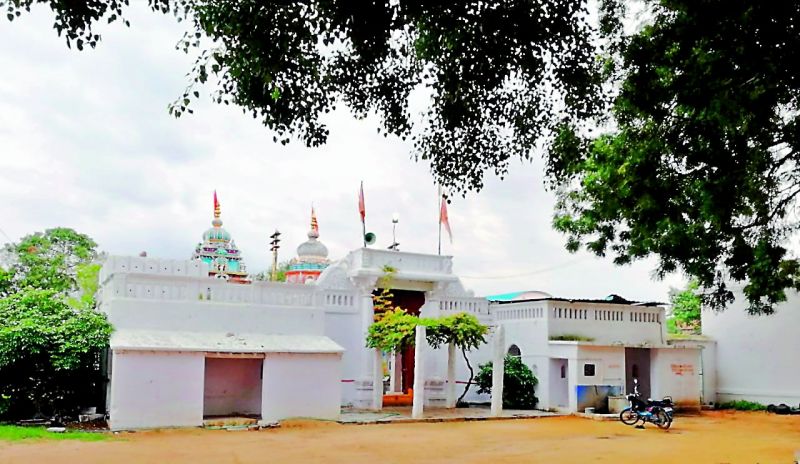An abode of Rama, Shiva
Worshippers get to pray both the gods in the same premises.

Hyderabad: Domakonda is one of those small villages, just four km off the highway from Nizamabad and 15 km from Kamareddy. Domakonda was one of the samsthanams under the Qutub Shahis and the Nizams but came into the limelight when superstar Chiranjeevi’s son Ram Charan Teja married Upasana Kamineni, daughter of the current heir of Apollo Hospitals Anil Kamineni, in 2012.
Keeping the wedding in mind, a lot of restoration work was carried out. A small function was held for the couple at the fort.
Apart from this little cinema fact, the Domakonda fort with two palaces and a temple complex has a name in history. The temple is dedicated to Lord Shiva and built in the Telangana style.
While the fort and the Shiva temple dominate Domakonda, there is another ancient temple, in fact two, side by side, a Hari Hara Kshetra — the Shri Shiva Rama Mandiram. With two dhwaja sthambas these temples are dedicated to Lord Vishveshwara and Lord Rama.
 The main temple which was recently renovated and whitewashed.
The main temple which was recently renovated and whitewashed.
There are rathams dedicated for the lords, highly colourful, ensconced in their own rathashalas. The red one belongs to Lord Rama with the namam in place and the blue ratham belonging to Lord Shiva with the lingam painted on top. They are used during festivals. It is only that these temples are outside the fort and do not get their due attention.
These temples were probably not built during the same period as the Shiva temple inside the fort, because their design and the architecture are quite different. The entrance to the temples is covered with bushes, concealing most of the wonderful stucco designs, but the main door is beautiful with lacey design on the wood.
 . The two Dwaja sthambas stand tall against the colourful old pillars.
. The two Dwaja sthambas stand tall against the colourful old pillars.
Not surprisingly, there is not much of known history of this temple and only the architecture and the materials tell us the story of this old structure.
Since it is one single structure, worshippers get to visit both the gods at the same time. At the Visvesvaraya temple, though small, there are a total of 11 lingas, all made of spatika (crystal), with 10 small ones surrounding the large one in the centre.
 The two rathams housed in the temple. The red one is for Lord Rama and the blue one for Lord Visvesvaraya.
The two rathams housed in the temple. The red one is for Lord Rama and the blue one for Lord Visvesvaraya.
The Ramalayam has the idols of Lord Rama, Sita and Lakshmana with a Lord Hanuman temple separately built. The icons are built of granite and placed atop the Shiva Prananatham, part of the Shiva Linga. There is a brass Prabhavali behind the icons and a separate temple dedicated to Annapurnadevi.
There are 16 colourful pillars, recently painted as are the two gopurams. Both the gopurams narrate different tales, including Lord Krishna’s antics. There are depictions of birds and animals and the pigeons made of stucco, and one can almost feel them cooing.
There is a huge ground dedicated to this temple with a small mandapam. Children use the ground to play cricket while the two rathashalas are at the other end of the ground. There is a beautiful peepul tree and a neem tree at one end near the well, with flowering bushes surrounding them. The peepul tree has a little sit-out where people still come and sit around for a chat, while the low parapet wall is painted with messages for people to absorb when they come to the temple ground.
There are two small buildings, now dilapidated, which can be used as homes. One of them belongs to the village revenue officer (VRO) and he pays rent to the temple. Little jalis and stucco work give these home an old look.
Apparently there were two builders of this temple according to the pantulu Ramakrishna Sharma. “I am the fourth generation,” he says. According to him, the two builders, Chinnayya and Peddayya, took jeevan samadhi. In their honour two samadhis were built and land was allocated within the temple complex. There is also an old devasthanam office.
There is yet another small Lord Shiva temple, next to an old temple well or koneru. This too has a spatika (crystal) lingam with a granite Nandi. “Earlier the temple well was called the Mota Bavi and the water would be pulled up by buffaloes for regular use,” said the pantulu.
There are a number of steps leading into the well, which is now filled with dried branches and fallen leaves.
The mukha (main) dwaram (gate) in the south is shut, people enter from the eastern gate which falls on the main market road of Domakonda.
The temple is crowded only during festivals, otherwise the shouts of children at play and murmurs of old people fill up the huge space.

